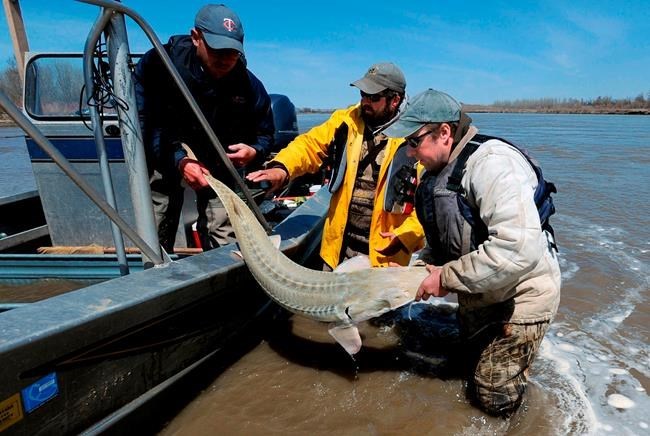
FILE - In this 2014 file photo, from left, Montana Fish, Wildlife and Parks employees Dave Fuller, Chris Wesolek, and Matt Rugg release a pallid sturgeon after taking blood samples from the fish in Montana. The 9th U.S. Circuit Court of Appeals ruled Wednesday, April 4, 2018, to allow construction of a $59 million dam that is in the center of a dispute over an endangered fish species. There are about 125 wild pallid sturgeon left in Montana's Yellowstone River, and wildlife advocates are concerned the fish won't use a planned bypass channel to swim around the dam to reach their spawning grounds.(James Woodcock/The Billings Gazette via AP, File)
Republished April 04, 2018 - 2:54 PM
Original Publication Date April 04, 2018 - 1:31 PM
HELENA, Mont. - A federal appeals court ruling Wednesday will allow construction to begin on a $59 million dam on Montana's Yellowstone River that wildlife advocates say could doom an endangered ancient fish species.
But the legal fight isn't over yet, and the U.S. government agency leading the project near the Montana-North Dakota border will wait for a separate court ruling before deciding how to proceed.
"This is an important step to move forward with this project to protect the endangered pallid sturgeon and other fish in the river while continuing to assure that irrigation needs are met," U.S. Army Corps of Engineers spokeswoman Jamie Danesi said.
The three-judge panel from the 9th U.S. Circuit Court of Appeals ruled Wednesday that the advocacy group Defenders of Wildlife did not prove the project would cause irreparable harm to the river's pallid sturgeon.
The panel also reversed U.S. District Judge Brian Morris' temporary block of the project because the appellate judges disagreed with Morris that Defenders of Wildlife was likely to win its lawsuit against the U.S. Army Corps of Engineers.
It's the second time that the courts have blocked and then ordered the project to go ahead over concerns about whether the 125 remaining pallid sturgeon would be able to swim around the dam to spawn.
Aaron Hall, the Rockies and Plains representative for Defenders of Wildlife, said his organization will still fight to prevent the dam from being built.
"We're still reviewing things and deciding where to go," he said.
Still pending is an April 19 court hearing in the lawsuit, when Morris will hear arguments on whether he should rule in favour of the advocacy group without a trial and permanently block the dam.
"We will have a clearer idea of our options and timeline following Judge Morris' decision," Danesi said.
The long-snouted pallid sturgeon, which evolved from fish that were alive in the age of dinosaurs, are already cut off from their spawning grounds by a wood-and-rock irrigation dam in eastern Montana.
Both the U.S. Army Corps of Engineers, which leads the construction project, and Defenders of Wildlife agree something needs to be done soon if the species is to survive.
But their solutions are very different. The Corps' project includes a man-made bypass channel for the fish to swim to their spawning grounds. Defenders of Wildlife is concerned that the fish won't use the bypass channel, and propose to make that section of river free-flowing and install pumps to provide river water for irrigation.
The irrigators who favour constructing the new dam applauded the 9th Circuit panel's ruling. James Brower, manager for the Lower Yellowstone Irrigation Project, noted that the appellate judges said the Corps had provided ample evidence that installing pumps instead of the proposed intake dam was unfeasible because of the huge costs associated with pumping.
"The most environmentally friendly court circuit we know of has ruled pumps would not be practical in our situation," Brower said.
Morris blocked the project last July after ruling the Corps hadn't properly analyzed the effects of the dam and bypass channel on the sturgeon. It was the second time Morris blocked the project after finding the Corps' environmental analysis fell short.
___
AP writer Matthew Brown in Billings contributed to this report.
News from © The Associated Press, 2018